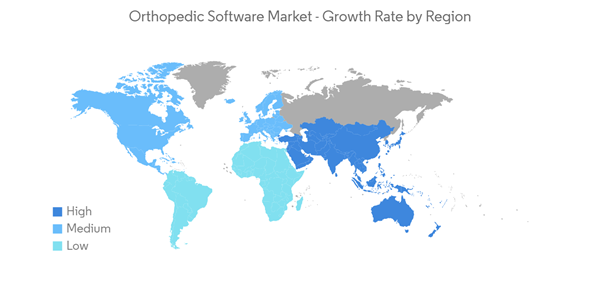The emergence of the COVID-19 pandemic impacted the market studied due to declined hospital and ambulatory surgical center visits because of the global lockdown restrictions imposed by the government. Also, in a few regions, the orthopedic and small hospitals were shut down or curtailed their operations and services. Other hospitals were converted to containment facilities and treatment wards for COVID-19 patients, which impacted the market growth. For instance, as per an article published by Orthopedic Surgery in May 2022, it was observed that the average number of elective surgeries, such as hip and knee replacement, decreased by 90%. In addition, as per the same source, the number of new patient visits decreased by 25.5% during the pandemic. However, orthopedic procedures are expected to increase with released restrictions, resumed services, and increased hospital visits. For instance, from an article published in June 2022, it has been found that the demand for key-hole surgeries in the shoulder joint increased by 20% to 40% in 2021. This is expected to fuel the demand for cloud applications and management services, which is anticipated to boost the growth of the orthopedic software market over the forecast period.
Certain factors attributing to the market growth are the increasing orthopedic problems and injuries, a rising aging population, the growing adoption of minimally invasive surgeries, increasing research and development, and rising technological advancements.
The rising number of people suffering from orthopedic problems and injuries is the key factor driving the market growth. For instance, the article published in the National Natural Science Foundation of China (NSFC) in June 2022 stated that the prevalence of knee joint osteoarthritis in China was higher in females than males. Also, from an article published in September 2022, it has been observed that the prevalence of self-reported joint pain or osteoarthritis has increased from 45.3% in 2020 to 54.7% in 2021 in Bangladesh. Thus, the growing burden of orthopedic disorders and associated surgeries is expected to increase the demand for smart software that helps carry out the anatomical assessment, planning, and measurements of the respective structures, such as knees and spines, which helps achieve optimal and revision-safe surgery preparation. This increases the adoption of software and applications in the orthopedic area and is anticipated to fuel market growth over the forecast period.
Additionally, the growing geriatric population across the globe is expected to increase the number of people suffering from orthopedic diseases, such as arthritis, osteoarthritis, and rheumatoid arthritis, as they are more prone to develop joint-related disorders due to weaker bones. For instance, as per an article published in PLOS One, in February 2021, about 50% of the elderly population aged 60 years or above is suffering from osteoarthritis, which limits their ability to engage in physical activity and causes pain and symptoms, such as joint stiffness and swelling, muscle weakness, and restricted range of motion.
Also, as per the data published by the UN in 2022, the number of people aged 65 years or above is expected to more than double globally by 2050, rising from 727 million in 2020 to 1.5 billion in 2050. Thus, the growing aging population is expected to increase the number of orthopedic problems and hospital visits for diagnosis, treatment, and surgeries. This is anticipated to augment the demand for advanced software that shows up the 3D structure of the bone and helps in accurate diagnosis and surgeries, thereby boosting the market growth.
Furthermore, the rising awareness regarding osteoporosis and other orthopedic disorders among the population is anticipated to increase the need for orthopedic EHR, templating, and preoperative planning software, which is expected to fuel the market growth over the forecast period. For instance, in Europe, the International Osteoporosis Foundation (IOF) is responsible for raising awareness of osteoporosis care. As per the report published by IOF in 2021, more than 23 million men and women are at high risk of osteoporotic fractures in the European Union.
Moreover, the rising company activities in launching software and cloud systems contribute to market growth. For instance, in August 2021, OrthoGrid Systems Inc. launched a new OrthoGrid Trauma Application, the latest application of OrthoGrid’s Surgical Digital Platform. Also, in January 2021, Ortoma AB launched an artificial intelligence-based software platform, OTS 5, to improve surgical accuracy. The platform has been developed for surgical instruments and includes many improvements to existing functionalities and various new ones. The latest version enhances usability before and after surgery and consists of an Ortoma Plan and Ortoma Guide.
However, the absence of healthcare insurance in emerging economies and the lack of skilled professionals are some factors impeding the market growth over the forecast period.
Orthopedic Software Market Trends
Orthopedic Electronic Health Record (EHR) Segment is Expected to Grow in the Orthopedic Software Market Over the Forecast Period
The orthopedic electronic health record (EHR) is expected to witness significant growth in the orthopedic software market over the forecast period owing to the factors such as the increasing orthopedic problems and injuries, rising adoption of minimally invasive procedures, and growing research and development as well as technological advancements.The rates of EHR adoption have increased across all health-service fields after the implementation of the Health Information Technology for Economic and Clinical Health (HITECH) Act. For instance, according to an article published by BMC Health Services in June 2021, it has been observed that patient-related outcome information is a prerequisite for patient-centered care, which has increasingly been recognized as an ethical imperative in modern health care. This is expected to propel the adoption of EHR systems in orthopedic centers and clinics, which is anticipated to fuel market growth over the forecast period.
Additionally, the rising company’s focus on developing technologically advanced applications and management software is also contributing to the market growth. For instance, in January 2021, Modernizing Medicine acquired orthopedics EHR vendor Exscribe. Modernizing Medicine and Exscribe works together to accelerate innovation and bring advanced EHR, practice management, and technology solutions intended to improve physician efficiency, reduce burnout, and support value-based care in the market. Also, in January 2021, WRS Health expanded its footprint with the availability of Orthopedics-Cloud. Orthopedics-Cloud is an EHR that meets the needs of orthopedic practices specializing in the musculoskeletal system.
Thus, owing to the aforementioned factors, the market is expected to grow significantly during the forecast period.
North America is Expected to Have the Significant Market Share in the Orthopedic Software Market over the Forecast Period
North America is expected to dominate the orthopedic software market over the forecast period owing to the factors such as the rising prevalence of orthopedic disorders, well-developed healthcare infrastructure, increasing demand for minimally invasive procedures, and growing technological advancements.In addition, with an increase in the geriatric population, there is a rise in the number of people suffering from various arthritis problems, which increases the demand for non-surgical procedures, hence contributing to the growth of orthopedic software in the region. For instance, according to the data published by America's Health Ranking in 2021 Senior Report, in the United States, more than 54 million adults aged 65 and older, which accounts for 16.5% of the total population and the total number of adults aged 65 and older is projected to rise to an estimated 85.7 million, accounting approximately 20% of the total population, by 2050.
Furthermore, the growing burden of arthritis, osteoarthritis, knee pain, and other orthopedic disorders drives the market growth. For instance, according to Statistics Canada 2021, approximately 5.9 million adult Canadians had arthritis in 2020. The prevalence of arthritis increases with age and is higher among females. In addition, according to data published by the CDC, in October 2021, an estimated 78.4 million adults aged 18 years and older are expected to have doctor-diagnosed arthritis by 2040. Thus, the expected increase in the number of people suffering from orthopedic disorders is anticipated to propel the number of treatment and surgical procedures, which is expected to increase the need for different orthopedic software for maintaining financial processes and health records, propelling the market growth in the region.
Moreover, the rising company's focus on developing applications and cloud-based systems for orthopedic providers is anticipated to boost the market growth over the forecast period. For instance, in October 2021, Breg Inc. launched Breg Vision 7.5, a completely rebuilt version of its trusted patient and inventory management software currently used by thousands of orthopedic clinics, hospital systems, and sports medicine programs to reduce administrative hassle and elevate patient care. It makes it easy for orthopedic providers to integrate the system directly into their existing EMR/EHR platforms.
Thus, owing to the factors above, the market is expected to grow significantly during the forecast period.
Orthopedic Software Market Competitor Analysis
The orthopedic software market is experiencing consolidation. The companies are focusing on merger and acquisition strategies and new product launches to improve their orthopedic software market-specific product profile. Key players in the market include Brainlab AG, GE Healthcare, Greenway Health LLC, IBM Corporation (Merge Healthcare Inc.), and Materialise NV, among others.Additional benefits of purchasing the report:
- The market estimate (ME) sheet in Excel format
- 3 months of analyst support
This product will be delivered within 2 business days.
Table of Contents
Companies Mentioned (Partial List)
A selection of companies mentioned in this report includes, but is not limited to:
- Athenahealth Inc.
- Brainlab AG
- CureMd Healthcare
- GE Healthcare
- Greenway Health LLC
- IBM Corporation (Merge Healthcare Inc.)
- Materialise NV
- Medstrat Inc.
- Nextgen Healthcare Information Systems LLC
- Breg Inc.
- mediCAD Hectec GmbH
- Rayence










